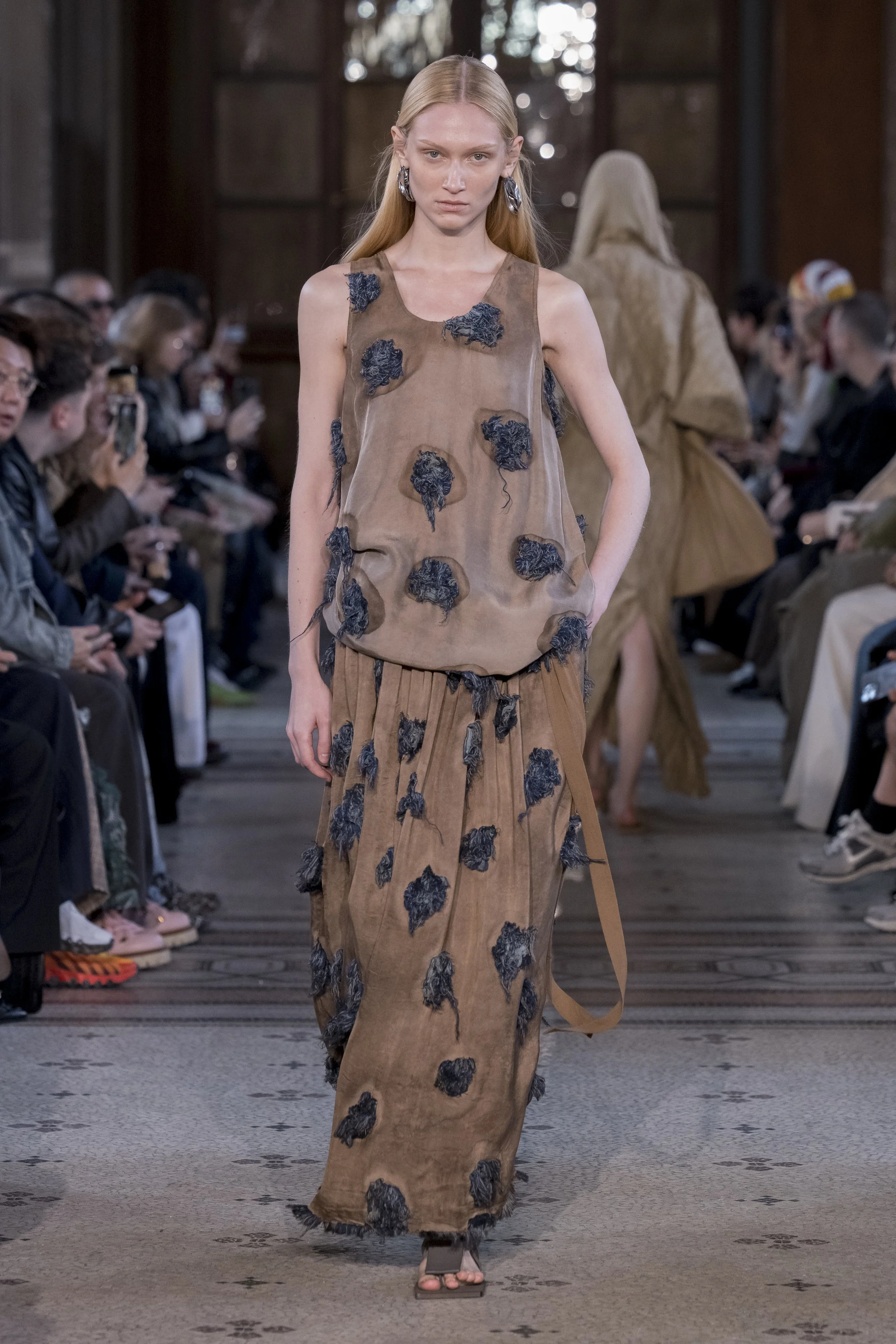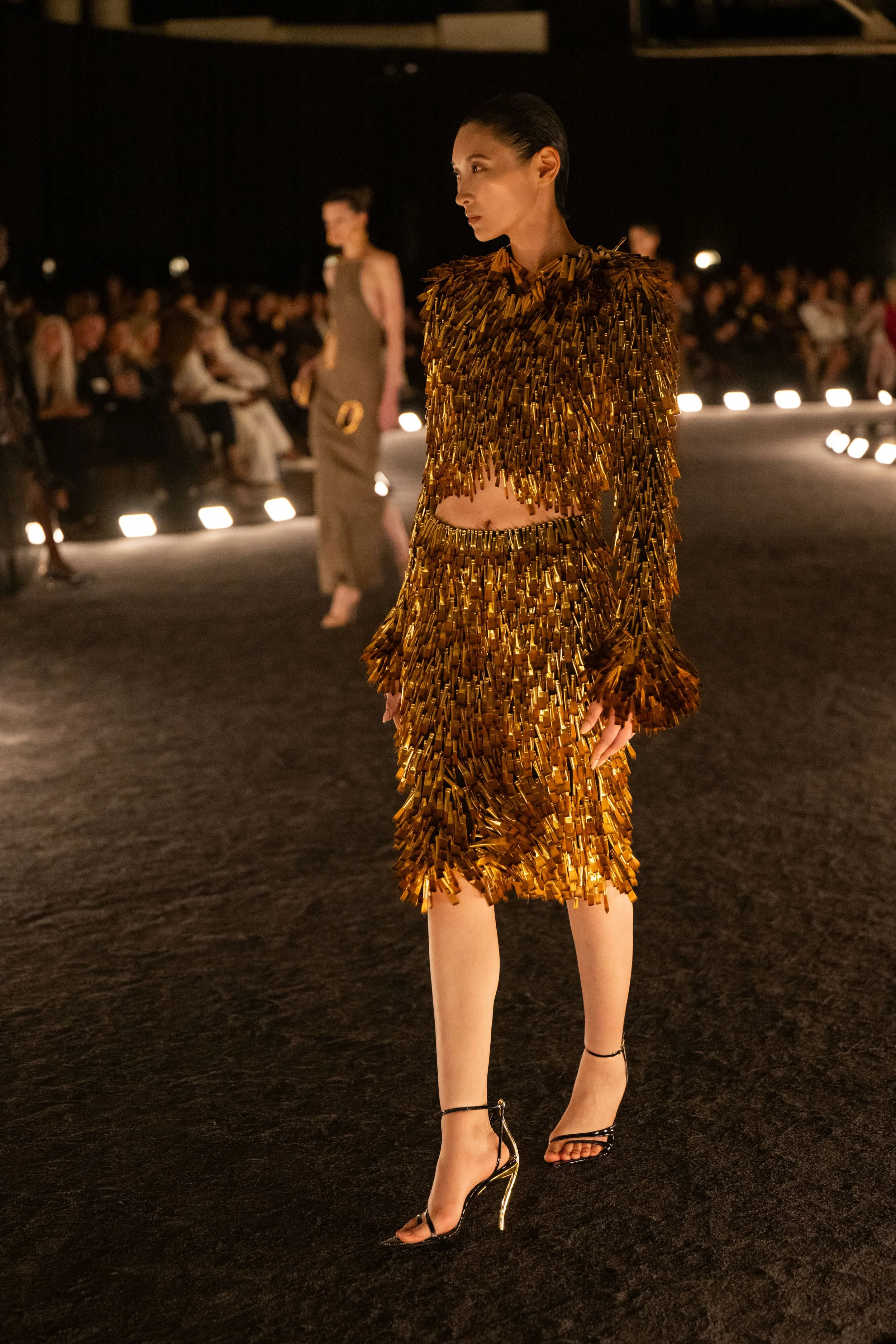PARIS FASHION WEEK SPRING/SUMMER 2026: DAY 4
editors ELIANA CASA, MAREK BARTEK, MARIA MOTA and MARIE-PAULINE CESARI
UMA WANG
review by MAREK BARTEK
all images UMA WANG provided by the brand
Change was the word on Uma Wang’s mind this season. Last time was about bows and cinched waists, and this spring was their undoing: silhouettes loosened, shoulders softened, and the body was freed into cascading lines. The inspiration came from marble — the draped statues of the Virtues in Mantua’s Palazzo Te — where fabric turned stone seems to twist, veil and fall forever. Wang translated that language into clothes that ripple with ease yet keep just enough structure to hold their shape.
The palette of travertine, fossil, dune and anthracite felt lifted straight from ancient walls, while fabric treatments mimicked age and erosion: a crinkle-coated jacket with the texture of parchment, jacquards that looked weathered but refined. Drapes and cutouts revealed quiet surprises at the back, while knotting, distressed knits and embroidery pushed texture forward. It was a collection of softness with strength, a quiet study in how to let fabric move like marble in motion.
MUGLER
review by MARIA MOTA
all images MUGLER provided by the brand
Mugler’s Spring/Summer 2026 show, Stardust Aphrodite, opened like the first scene of a cinematic trilogy, setting the tone for a journey through fantasy, decadence, and the language of desire. Miguel Castro Freitas, the Portuguese designer behind the creative direction of the brand, grew up in Santarém, far from Paris, but his résumé is pure fashion lore: Central Saint Martins womenswear graduate, Dior under John Galliano with a focus on haute couture and special projects for celebrities, Dries Van Noten, Lanvin, Yves Saint Laurent, and, most recently, Sportmax.
Freitas looked inward, drawing on Mugler’s signature body-sculpted silhouettes and its flair for sensuality and theatricality. The result retained the hyper-feminine shapes and high drama the house is known for, but with a new calm confidence underneath, a sense of maturity and sophistication. Exaggeration remained, though now a bit more modest.
Hourglass tailoring, volumes, feathers, latex, pastels, and satin created an unexpected interplay between excess and subtlety. Maximalist flamboyance was balanced with quiet moments, as bare skin became the ultimate luxury fabric, worn like a second layer. Matte jewelry pieces replaced clothing. Flesh tones in every shade ran through the palette, followed by accents of black and pops of color. The effect was a conversation across eras: Thierry Mugler’s operatic drama, Casey Cadwallader’s futuristic charge, and now Freitas’s grown-up sensuality.
Stardust Aphrodite is part one of a “Trilogy of Glorified Clichés,” hinting at deeper explorations to come. It revived Old Hollywood glamour and the fetishised figure of the showgirl. In the front row, among many other stars, sat Pamela Anderson and Elizabeth Berkley, real-life embodiments of that myth. Their legacies were reframed in real time. It’s not just about feathers and glitter, but about the contradictions embodied by these characters of cabarets and silver screens, always caught between fantasy and reality.
The setting mirrored the collection’s tension. A moody, raw underground parking lot with velvet seats waiting for guests, juxtaposing concrete severity with boudoir intimacy. The foundation has been laid, one that nods to Mugler’s past while clearly charting a path forward. And if this first act is any indication, the next chapters will be thrilling.
RICK OWENS
review by NIA TOPALOVA
all images RICK OWENS via vogue.com
Designed not to please, Rick Owens’ SS26 women’s collection was unmistakably brutal in form yet strictly precise in execution. Coinciding with the opening of his retrospective Temple of Love across the street at Palais Galliera, the show began with models walking ankle-deep on water, across the flooded floor of the Galliera courtyard’s grey skies. Below, a disturbingly reversed loop of Jefferson Airplane’s Somebody to Love played in slow distortion, dragging the song’s optimism backwards.
Dresses and skirts were whipped into form with control, crafted from recycled nylon and latex-dipped sequined tulle manipulated by Paris fetish artist Matisse Di Maggio. Every panel was dipped, dried, brushed, and polished until it reached a hardened, crust-like surface. Beneath, sheer architectural layers mapped the naked body without exposing it, flirting with vulnerability but offering none. Cropped trench jackets were layered over long matching vests to build compressed, functional silhouettes. Leather jackets with Dracu collars and weeping fringe appeared beside washed-out flight jackets in faded, cotton-candy tones. Straytukay’s heavyweight handwoven leathers, tanned in Tuscany, added movement, letting weight articulate the body.
The Suicide collaboration grounded the collection in minimalist violence. Alan Vega and Martin Rev’s legacy was translated into deconstructed leathers produced in Hyogo Prefecture, Japan. The materials carried a sense of mortality, feeling worn, lived-in, and at times already in the process of decay.
Rick Owens builds spaces where resistance and vulnerability coexist, delivering garments that challenge the way we perceive the human body, its movements, and how it holds up under pressure. The collection demanded a deeper engagement with form and function, endurance and complexity, where the body is both protected and exposed, and clothing becomes an actual tool of survival.
VIKTOR&ROLF
review by PHOEBE PHOEBE GIBSON-DOUGALL
all images VIKTOR&ROLF provided by the brand
In March of this year, after a decade-long hiatus, the fashion world was blessed with Viktor&Rolf’s ready-to-wear return. During their absence, the Dutch duo made haute couture their sole focus, a decision which heavily influenced their SS26 collection. Describing ready-to-wear as “…a souvenir we’ve brought back from the world of haute couture” the pair’s latest offering “translates the house’s minimal baroque spirit into sculptural silhouettes.” This was most evident in this season’s dresses, a focal point for the collection. Dramatic bows and ruffles adorn both minis and full-length gowns, juxtaposed against sleeker, more severe dresses. There is also creative exploration with denim pieces; sculpted jackets and ballooning pants are reimagined in the fabric, showing off the pair’s haute couture pedigree. This collection continues Viktor&Rolf’s victorious return to the world of ready-to-wear and presents a poetic new vision for what it can be.
CHRISTIAN WIJNANTS
review by PHOEBE PHOEBE GIBSON-DOUGALL
all images CHRISTIAN WIJNANTS via vogue.com
Florals for spring? No; much like Miranda Priestly, Christian Wijnants doesn’t think so. Comprised of a muted palette-save for some leopard print!-the Belgian designer’s SS26 collection favoured texture and cut over colour and print. Icy pinks and blues walked the runway alongside classic black, white, and ecru pieces. Inspired by the work of the late Malian photographer, Seydou Keïta, Wijnants chose to display “sophistication and quiet intimacy” with this collection, preferring technical creations and fleshed-out shapes. A halter-necked crochet top shared the runway with a full outfit of deconstructed, washed black denim. Flowy dresses that can be dressed up or down were contrasted against more impressive pieces. The real showstopper being a long, black dress that closed the presentation, hand-knitted and time-intensive, but beautifully showcasing the designer’s craft. I can’t say for sure, but I like to think that Christian’s collection would be as pleasing to Ms Priestly as it is to me.
SCHIAPARELLI
review by MAREK BARTEK
all images SCHIAPARELLI provided by the brand
Daniel Roseberry likes to say that Schiaparelli should feel like going to a museum, and last night at the Pompidou, which will soon close for renovations, he proved it again. “What once felt like a liability feels like a superpower,” he said of his ready-to-wear’s couture intensity. Rather than listening to the criticism and choosing between one or the other, Roseberry fused them until they became inseparable.
The opening skirt suits looked formal at first glance, until you noticed the padding flipped inside out, hips and shoulders exaggerated into sculptural accents. Knit dresses traced the body with trompe l’oeil nudes, a witty nod to Elsa herself, while bias-cut gowns featuring surreal “rips,” referenced the house’s closeness to Dalí. A suit bristling with paintbrushes turned into fur was pure theatre. Accessories consisting of melted-clock handbags, salt-lamp jewels lit from within, and shoes with toe nails or elegant laces. Ready-to-wear or couture? Roseberry is done drawing the line. This is Schiaparelli as fantasy for everyday life.
ISABEL MARANT
review by MARIA MOTA
all images ISABEL MARANT via vogue.com
Just by stepping into the show space, it was clear that Isabel Marant’s Spring/Summer 2026 collection, designed by Creative Director Kim Bekker, was drawn to the sun and the heat. Not just in palette, and with its desert-like floors, but in spirit: a hot collection, a hot cast, a hot attitude, and a soundtrack to match.
Dusty pathways became runways for textured bombers, sheer tanks, and glittering metallic knits, revealing Bekker’s take on Marant’s signature bohemian ease. At the heart of the collection was comfort and freedom. Loose draping, dropped waists, and relaxed bottoms allowed garments to move fluidly. Menswear leaned into effortless sensuality, with slouchy silhouettes, open-stitch knits, and suede-and-leather trousers offset by sun-worn beige anoraks. Womenswear shimmered with soft textures and neutral hues: frayed dresses, swimwear, and delicate embroidery that caught the light as models walked.
Playful rope details opened up styling possibilities, adding a laid-back, travel-ready energy. Functionality met femininity in trousers cropped just enough to stay clear of the “sand,” and in washed silks, soft jerseys, and leathers embossed and weathered by heat. Featherlight crochet, scarves knotted at the waist, and asymmetric ruffles rippled across tops and skirts, introducing a flowing rhythm. Utility played its part too. Cargo trousers and jackets in weightless fabrics brought pragmatic structure, with oversized flap pockets and totes slung casually over shoulders. Asymmetrical earrings punctuated the looks, drawing the eye to subtle, intentional details.
Accessories stole the spotlight: heels adorned with delicate leather flowers and slouchy flat boots immediately drew attention to the ground. While slouchy duffle and shoulder bags reinforced the collection’s easy, wandering spirit. Natural shades of sand, ecru, pale yellow, and bronze dominated the opening looks, infusing the collection with the warmth beneath the sun, the freedom of walking on sand, and the confident motion of a traveler. As the show progressed, the palette deepened, transitioning from the brightness of morning to the cooler tones of evening.
Isabel Marant SS26 felt like a desert odyssey, a journey through textures and layers, carried by the confident stride of the modern Marant woman.





















